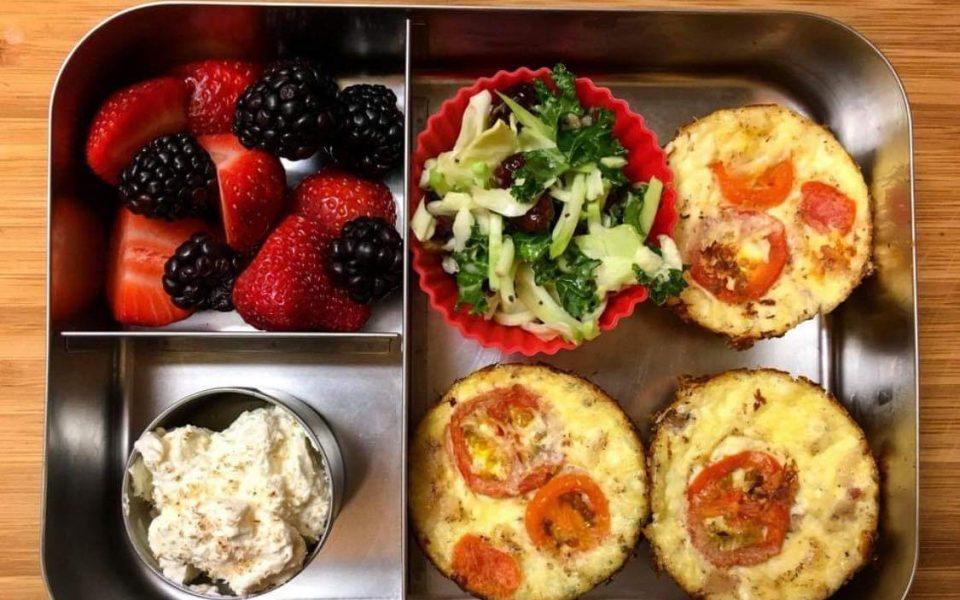The most iconic scenes in movies about school are the those set in the cafeteria. Nerds over here, jocks over there and the “You can’t sit with us” table. The fictional depiction of the lunchroom hierarchy has less to do with what kids are eating and more about social standing. But in today’s lesson, we’re talking to parents about what they’re packing for lunch, how they’re packaging it and if their kids are eating what’s been packed for them.
Amy Barton’s 11-year-old son Jay hates sandwiches, which can be a problem.
“I have found the website tablespoon.com to be helpful,” she says. “They have great appetizers that I make on the weekend and send all week.”
She’s made empanadas, macaroni-and-cheese bites and cheeseburger sliders.
“It has worked out really well,” Barton says. “He gets to help choose what we make. If we run across a dud, he has to finish what we made, and we mark that one off the list.”
Meal prep on the weekends and at night help for quick packing in the morning, and result in healthier lunches than packaged food.
Samantha Absher used to do “fancy” lunches for her teenaged sons. While some parents’ main concern is food allergens, Absher had another detail to contend with.
“We were getting my youngest off of processed food in an attempt to get his ADHD under control,” she explains.
In a concerted effort to pack diverse and colorful meals that her kids would actually eat, she turned to reusable bento boxes and silicone cupcake liners to make lunch great again.
Bento is a home-packed meal common in Japanese cuisine. A traditional bento holds rice, noodles, meat and vegetables, all neatly packed in a box. Containers range from mass-produced disposables to hand-crafted ceramic and melamine-coated boxes. Parents in the Triad use the same techniques, like Absher, to create interesting and creative choices for the kids.
One day it could be an egg wrap with prosciutto, greens with sweet balsamic dressing, cherry tomatoes and blackberries with almond-flour shortbread cookies dipped in orange dark chocolate. On another, they might find mini pancetta and goat-cheese quiches with tomatoes, kale-and-cabbage salad with mixed berries and vanilla whipped cream under the lid.
“People always say, ‘I wish my kids would eat that stuff!’” she says. “They didn’t at first. And guess what? They were hungry in the afternoon. It’s a natural consequence of choosing not to eat, and they lived.
“After about two weeks they were telling me how they’d get so excited to see what was in their lunch boxes each day,” she adds.

Jennifer Fletcher just found out that her second-grader, Jude, is in a nut-free room this year.
“I hate it so much,” she says. “Not that I can’t pack my favorite convenience food, but because there are children and people out there with such life-threatening allergies that they can’t even leave their house or invite people into their house without the threat of dying.”
According to the Food Allergy and Research Education organization, researchers estimate that 32 million Americans have food allergies, including 5.6 million children under age 18. That’s one in 13 children, or roughly two in every classroom.
Jennifer’s son, Jude, is a vegetarian and is somewhat persnickety in his diet. But Fletcher says he is used to taking a variety of things.
“Sometimes we send leftovers, sometimes macaroni and cheese with peas, little squares of cheese with crackers, veggie dogs, chicken-less fingers,” she says. “He used to take peanut-butter sandwiches or apples with peanut butter to dip them in, but we will just omit that from his lunch this year. Possibly in the future, too. I plan to tell his teacher that he can always count on his being nut-free so that he can sit at the nut-free table at lunch. I hate the idea of kids feeling isolated due to a ‘difference.’
“Our food preference is not greater than the safety of another person. So, we will happily pack all the other alternatives.”
The diversity of the midday meal in school varies from student to school to region and expands beyond cultural and taste preferences at every turn. This year as students go back to school, hopefully new favorites will emerge from the classic lunchbox.
Join the First Amendment Society, a membership that goes directly to funding TCB‘s newsroom.
We believe that reporting can save the world.
The TCB First Amendment Society recognizes the vital role of a free, unfettered press with a bundling of local experiences designed to build community, and unique engagements with our newsroom that will help you understand, and shape, local journalism’s critical role in uplifting the people in our cities.
All revenue goes directly into the newsroom as reporters’ salaries and freelance commissions.


Leave a Reply